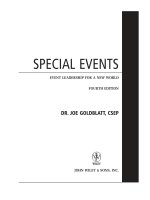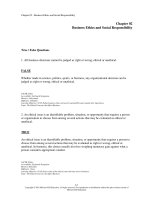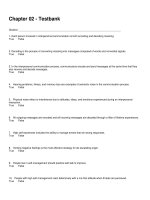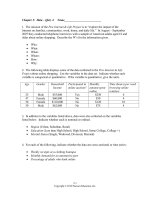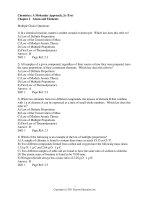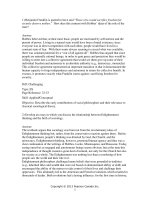Business communication developing leaders for a networked world 2nd edition cardon test bank
Bạn đang xem bản rút gọn của tài liệu. Xem và tải ngay bản đầy đủ của tài liệu tại đây (389.86 KB, 73 trang )
Chapter 02
Interpersonal Communication and Emotional Intelligence
True / False Questions
1.
Each person involved in interpersonal communication is both encoding and decoding meaning.
True
2.
False
Decoding is the process of converting meaning into messages composed of words and nonverbal
signals.
True
3.
False
In the interpersonal communication process, communicators encode and send messages at the
same time that they also receive and decode messages.
True
4.
False
Hearing problems, illness, and memory loss are examples of semantic noise in the communication
process.
True
5.
False
Physical noise refers to interference due to attitudes, ideas, and emotions experienced during an
interpersonal interaction.
True
False
2-1
Copyright © 2016 McGraw-Hill Education. All rights reserved. No reproduction or distribution without the prior written consent of
McGraw-Hill Education.
6.
All outgoing messages are encoded and all incoming messages are decoded through a filter of
lifetime experiences.
True
7.
High self-awareness includes the ability to manage events that stir strong responses.
True
8.
False
Venting negative feelings is one of the most effective strategies for de-escalating anger.
True
9.
False
False
People who have low self-management should practice self-talk to improve.
True
False
10. People with high self-management react defensively with a me-first attitude when threats are
perceived.
True
False
11. Recent business-school graduates rank listening skills among the most important communication
skills.
True
False
12. In a conversation with a co-worker, Kosuke agrees with everything the other person says. Kosuke is
successfully practicing the skill of holding judgment.
True
False
13. During a conversation with his supervisor, Alec paraphrases something that he heard her say. This
is an example of a judger statement.
True
False
2-2
Copyright © 2016 McGraw-Hill Education. All rights reserved. No reproduction or distribution without the prior written consent of
McGraw-Hill Education.
14. Sharing your own ideas with your colleagues undermines the active listening process.
True
False
15. Probing questions are intended to create bonds between people.
True
False
16. Leading questions are generally open-ended.
True
False
17. Nonverbal messages, such as posture, are most important when they convey a different emotion
than the spoken message.
True
False
18. A person's motivational value system is a blend of the three primary motives of nurturing,
dominating, and autonomizing.
True
False
19. A manager who wants to hire an effective leader should focus on applicants who are extroverts.
True
False
20. When one is treated poorly, responding aggressively potentially de-escalates a difficult situation
and shows one's character and caring.
True
False
Multiple Choice Questions
2-3
Copyright © 2016 McGraw-Hill Education. All rights reserved. No reproduction or distribution without the prior written consent of
McGraw-Hill Education.
21. Which of the following terms best describes the process of sending and receiving verbal and
nonverbal messages between two or more people?
A. active listening process
B. verbal communication process
C. interpersonal communication process
D. thought process
E. review process
22. Melissa intends to say something to the new employee that will make him feel welcome as a
member of the team. The thought that Melissa intends to communicate is known as _____.
A. meaning
B. message
C. semantics
D. encoding
E. empathy
23. _____ is the process of converting meaning into messages composed of words and nonverbal
signals.
A. Decoding
B. Encoding
C. Translating
D. Filtering
E. Communicating
2-4
Copyright © 2016 McGraw-Hill Education. All rights reserved. No reproduction or distribution without the prior written consent of
McGraw-Hill Education.
24. Ayesha says, "You're so generous!" in a sarcastic tone. Mario decides that Ayesha thinks he is
cheap. What process has Mario just done?
A. filtering
B. hijacking
C. encoding
D. synchronizing
E. decoding
25. Loud music coming from the next room or distorted formatting in an email message are examples
of _____ noise.
A. physical
B. psychological
C. semantic
D. physiological
E. cognitive
26. _____ noise occurs when communicators apply different meanings to the same words or phrases.
A. Psychological
B. Physical
C. Semantic
D. Cognitive
E. Physiological
2-5
Copyright © 2016 McGraw-Hill Education. All rights reserved. No reproduction or distribution without the prior written consent of
McGraw-Hill Education.
27. Which of the following is an example of psychological noise?
A. Jenna's boss does not understand what she tells him because his hearing aid battery dies.
B. Jenna's boss does not understand that when she says a product is "bad," she means she likes it.
C. Jenna's boss does not take her complaint seriously because construction noise prevented him
from hearing it.
D. Jenna's boss does not take her complaint seriously because he thinks teenagers always
exaggerate.
E. Jenna's boss does not remember what she tells him because he has another meeting right after
their conversation.
28. All outgoing messages are encoded and all incoming messages are decoded through
A. a filter of lifetime experiences.
B. psychological noise.
C. mitigating information.
D. a motivational value system.
E. sight-reading.
29. Emotional _____ refers to a situation in which emotions control our behavior causing us to react
without thinking.
A. filtering
B. hijacking
C. blackmail
D. noise
E. intelligence
2-6
Copyright © 2016 McGraw-Hill Education. All rights reserved. No reproduction or distribution without the prior written consent of
McGraw-Hill Education.
30. Which of the following is the process of accurately understanding one's own emotions as they
occur and how they affect one's behavior and thought?
A. self-management
B. empathy
C. relationship management
D. shared meaning
E. self-awareness
31. Events that cause strong emotional reactions are called _____.
A. triggers
B. stressors
C. noise
D. distracters
E. filters
32. Jeanne pays close attention to her emotions at work and takes a quick break whenever she thinks
her frustration level might cause her to lash out at a co-worker. What quality does this behavior
demonstrate?
A. empathy
B. self-management
C. emotional hijacking
D. sight-reading
E. psychological noise
2-7
Copyright © 2016 McGraw-Hill Education. All rights reserved. No reproduction or distribution without the prior written consent of
McGraw-Hill Education.
33. Which of the following involves the discipline to hold off on current urges to meet long-term
intentions?
A. empathy
B. self-awareness
C. self-management
D. relationship management
E. sight-reading
34. Which of the following domains of emotional intelligence is the "ability to accurately pick up on
emotions in other people and understand what is really going on with them"?
A. empathy
B. relationship management
C. self-management
D. self-awareness
E. pessimism
35. Which of the following is an impact of low self-management on interpersonal communication?
A. One directs conversations to topics that are important to self.
B. One focuses exclusively on the task at hand without paying attention to rapport-building.
C. One provides indirect and vague feedback and ideas to others.
D. One frequently vents frustrations without a constructive work purpose.
E. One is unaware of his or her own emotional states and its related impacts on communication.
2-8
Copyright © 2016 McGraw-Hill Education. All rights reserved. No reproduction or distribution without the prior written consent of
McGraw-Hill Education.
36. Which of the following is an impact of high self-management on interpersonal communication?
A. One controls emotional impulses that are not aligned with work and relationship goals.
B. One attempts to understand the feelings, perspectives, and needs of others.
C. One engages in a me-first approach to work with colleagues.
D. One accepts and even welcomes feedback and constructive criticism.
E. One is aware of triggers and related tendencies to say the wrong thing.
37. Which of the following is an impact of high empathy on interpersonal communication?
A. One controls emotional impulses that are not aligned with work and relationship goals.
B. One directs conversations to topics that focus on the needs of others and self.
C. One is aware of triggers and related tendencies to say the wrong thing.
D. One spends a higher percentage of work conversations on work-related topics with a focus on
solutions.
E. One frequently vents frustrations without a constructive work purpose.
38. Juan tries to build rapport with the people on his project by checking in with them each day to see
if they have any questions or concerns. What aspect of emotional intelligence does this behavior
demonstrate?
A. high empathy
B. high self-awareness
C. high relationship management
D. low self-management
E. low empathy
2-9
Copyright © 2016 McGraw-Hill Education. All rights reserved. No reproduction or distribution without the prior written consent of
McGraw-Hill Education.
39. Which of the following is a strategy to improve relationship management?
A. Engage in relaxation techniques to clear your mind.
B. Practice self-talk and visualize yourself responding effectively to challenging interpersonal issues.
C. Constantly evaluate your feelings and moods; attempt to understand your feelings as they
occur.
D. Build up the courage to have a difficult conversation.
E. Reflect on personal strengths, weaknesses, and values.
40. Which of the following is a strategy to improve self-management?
A. Encourage others who rarely speak up to voice their thoughts and feelings.
B. Think about group dynamics and the related impacts on each team member.
C. Examine strategies for overcoming impulses that compete with achieving your long-range
goals.
D. Think about your last reactions to the following experiences: joy, anger, self-doubt, frustration.
E. Attend work-related social outings.
41. Which of the following is most likely to be true of those people who have low empathy?
A. They often repress their emotions and then respond inappropriately to situations.
B. They seize any opportunity to talk about their own past accomplishments.
C. They frequently use meeting time to complain about issues unrelated to the current task.
D. They go out of their way to explain company procedures to new co-workers.
E. They listen carefully to what others say and then ask questions to clarify what they heard.
2-10
Copyright © 2016 McGraw-Hill Education. All rights reserved. No reproduction or distribution without the prior written consent of
McGraw-Hill Education.
42. Which of the following is a domain of emotional intelligence?
A. shared meaning
B. sympathy
C. self-management
D. semantics
E. synchronizing
43. When Jamie listens to a customer, she maintains eye contact, nods when appropriate, and ignores
her phone when it gives an incoming message alert. Which active listening skill is she using?
A. reflecting
B. holding judgment
C. summarizing
D. clarifying
E. paying attention
44. Which of the following is an example of the active listening skill of clarifying?
A. Trung leans slightly forward as he listens to others.
B. Trung asks questions that demonstrate his desire to understand other points of view.
C. Trung asks the other person to explain a point more completely.
D. Trung expresses his own perspective after he has heard the other person.
E. Trung pauses to think about what he has heard and then paraphrases it.
2-11
Copyright © 2016 McGraw-Hill Education. All rights reserved. No reproduction or distribution without the prior written consent of
McGraw-Hill Education.
45. In a meeting with a supplier, Janice listens to his sales pitch and then says, "So the two main
advantages of this product are that it will save us money and it is better for the environment. Is
that correct?" What active listening skill has Janice used?
A. clarifying
B. paying attention
C. reflecting
D. summarizing
E. sharing
46. Which active listening skill involves demonstrating a learner mindset rather than a judger mindset?
A. holding judgment
B. paying attention
C. reflecting
D. summarizing
E. sharing
47. Which of the following statements is a judger statement rather than a learner statement?
A. Aren't you interested in trying new techniques?
B. How long do you think it will take to implement this new program?
C. What do the studies indicate the environmental impact will be?
D. How much do you estimate this will cost?
E. What other companies have tried this type of sales campaign?
2-12
Copyright © 2016 McGraw-Hill Education. All rights reserved. No reproduction or distribution without the prior written consent of
McGraw-Hill Education.
48. Which barrier to effective listening involves neglecting listening because of pressing deadlines?
A. lack of time
B. lack of patience and attention span
C. image of leadership
D. communication technology
E. fear of bad news or other uncomfortable information
49. A series of questions that attempt to deconstruct a business issue by moving from general to
specific are known as _____ questions.
A. rapport-building
B. funnel
C. probing
D. closed
E. solution-oriented
50. Sylvie starts her weekly department meetings by asking questions such as, "How was your
vacation?" "Did anyone see the football game last night?" and "Who wants to go to lunch after we
finish here?" What type of questions are these?
A. closed
B. rapport-building
C. solution-oriented
D. probing
E. funnel
2-13
Copyright © 2016 McGraw-Hill Education. All rights reserved. No reproduction or distribution without the prior written consent of
McGraw-Hill Education.
51. Customers have been complaining about the products produced by Derek's department. His team
has checked all the equipment, but they cannot find the cause of the poor quality. What kind of
questions would most help them with this issue?
A. solution-oriented
B. rapport-building
C. probing
D. closed
E. funnel
52. What is the main difference between probing questions and solution-oriented questions?
A. Probing questions move from general to specific, while solution-oriented questions move from
specific to general.
B. Probing questions tend to be analytical and focused, while solution-oriented questions tend to
be casual and social.
C. Probing questions tend to be closed, while solution-oriented questions tend to be open-ended.
D. Probing questions seek to uncover root causes, while solution-oriented questions focus on what
should be done.
E. Probing questions tend to have a judger mindset, while solution-oriented questions tend to
have a learner mindset.
53. The act of anticipating intentions and moods through the perceptive examination of nonverbal
cues is known as _____.
A. sight-reading
B. emotional intelligence
C. shared meaning
D. relationship management
E. self-management
2-14
Copyright © 2016 McGraw-Hill Education. All rights reserved. No reproduction or distribution without the prior written consent of
McGraw-Hill Education.
54. What does research consistently demonstrate about nonverbal communication?
A. People are not good at masking their feelings, and most people are highly skilled in their ability
to decode nonverbal signals.
B. People are not good at masking their feelings, but most people are incapable of decoding
nonverbal signals.
C. People are good at masking their feelings, but most people still manage to decode nonverbal
signals.
D. People are good at masking their feelings, so most people are incapable of decoding nonverbal
signals.
E. People are not good at masking their feelings, but most people are inconsistent in their ability to
decode nonverbal signals.
55. During a budget meeting, Eva concludes her part of the talk and points to her presentation
partner. What does this gesture most likely mean in context?
A. She is indicating that it is his turn to speak.
B. She is accusing him of interrupting her.
C. She is blaming him for the poor budget numbers.
D. She is giving him permission to ask a question.
E. She is trying to get him to be quiet.
56. When Leo had to tell Tania that her project had lost its funding, he found himself adopting a
slumped posture that was similar to hers. What was Leo doing?
A. synchronizing body language to mock her
B. synchronizing body language to show empathy
C. faking a mood to change her emotions
D. using visual cutoff to encourage sharing
E. using visual cutoff to make the conversation end
2-15
Copyright © 2016 McGraw-Hill Education. All rights reserved. No reproduction or distribution without the prior written consent of
McGraw-Hill Education.
57. Kim is a salesperson who has learned to gauge her customers' interest from their eyes. Which of
the following is most likely to indicate that her customer is carefully considering her product?
A. small, constricted pupils in the eyes
B. an abrupt look away by the eyes
C. a rapid sideways movement of the eyes
D. a lengthy sideways movement of the eyes
E. fast blinking of the eyes
58. Which motivational value system is most often guided by concerns that business activities have
been thought out carefully and the right processes are put into place to accomplish things?
A. red MVS
B. yellow MVS
C. blue MVS
D. green MVS
E. hub
59. Which of the following statements best expresses a typical concern of someone with a blue MVS?
A. "Let's make sure everyone feels included in the decision-making."
B. "Let's be sure that we have thought out the long-term results of this."
C. "Let's consider the most efficient way to implement this decision."
D. "Let's look at how this relates to the overall welfare of the company."
E. "Let's act in a way that provides clear leadership to others."
2-16
Copyright © 2016 McGraw-Hill Education. All rights reserved. No reproduction or distribution without the prior written consent of
McGraw-Hill Education.
60. Focusing on _____ is most likely to help you communicate with a red MVS in a way that he or she
prefers.
A. feelings
B. results
C. teamwork
D. flexibility
E. caution
61. Claire and Raul disagree about a proposal for the company to adopt flexible work schedules. Claire
wants to make sure that they have thoroughly investigated other companies that have such
schedules, while Raul wants to make the change happen before summer. What can you deduce
about Claire and Raul?
A. Claire is a green MVS; Raul is a blue MVS.
B. Claire is a red MVS; Raul is a hub.
C. Claire is a green MVS; Raul is a red MVS.
D. Claire is a hub; Raul is a red MVS.
E. Claire is a blue MVS; Raul is a green MVS.
62. Which of the following qualities is characteristic of people who are hubs?
A. nurturing
B. decisive
C. analytical
D. flexible
E. competitive
2-17
Copyright © 2016 McGraw-Hill Education. All rights reserved. No reproduction or distribution without the prior written consent of
McGraw-Hill Education.
63. Which of the following qualities is more characteristic of introverts?
A. thoughtful
B. charismatic
C. spontaneous
D. lively
E. collaborative
64. Which of the following situations would an extrovert prefer?
A. a quiet meeting with two friends
B. a loud party with a large group
C. time alone with a book
D. a work space in a library
E. a long conversation with one person
65. Phil needs to assign his team members the following tasks. One of the team members, Mary, is an
introvert. Which task is most appropriate for Mary?
A. attending the annual sales meeting to help sales people understand a new product
B. giving a presentation about the new product to senior management
C. checking the proofs of sales brochures for accuracy before they are printed
D. moderating a team meeting to discuss how well the last development cycle went
E. entertaining a group of colleagues visiting from another city
66. Extroverts can work more effectively with introverts by
A. speaking up more quickly than feels comfortable to them.
B. shortening the length of their emails.
C. offering personal information more often than feels natural.
D. pausing more often and allowing periods of silence that might feel uncomfortable.
E. explaining that they prefer to answer questions after they have time to think.
2-18
Copyright © 2016 McGraw-Hill Education. All rights reserved. No reproduction or distribution without the prior written consent of
McGraw-Hill Education.
67. Tom always drops hand-written reports on his administrative assistant's desk and says, "Type this
right away." What type of incivility is Tom committing?
A. treating others without courtesy
B. ignoring others
C. disrespecting the dignity and worth of others
D. disrespecting the efforts of others
E. disrespecting the privacy of others
68. Which of the following is an example of disrespecting the dignity and worth of others?
A. claiming credit for a co-worker's creative idea
B. calling female co-workers "honey" or "baby"
C. forwarding a confidential email from the boss
D. arriving at a meeting late
E. leaving a mess in the kitchen area
69. Which of the following is a guiding principle on improving civility in society and the workplace?
A. Tell, don't ask.
B. Ignore small things.
C. Disagree graciously.
D. Do not refrain from arguing.
E. Keep a negative attitude.
70. _____ is "rudeness and disregard for others in a manner that violates norms for respect."
A. Emotional hijacking
B. Semantic noise
C. Pessimism
D. Incivility
E. Visual cutoff
2-19
Copyright © 2016 McGraw-Hill Education. All rights reserved. No reproduction or distribution without the prior written consent of
McGraw-Hill Education.
Essay Questions
71. Define interpersonal communication process.
72. What do the words meaning, encoding, and decoding refer to in interpersonal communication?
73. Explain physiological noise with examples.
2-20
Copyright © 2016 McGraw-Hill Education. All rights reserved. No reproduction or distribution without the prior written consent of
McGraw-Hill Education.
74. How does emotional hijacking hinder effective interpersonal communication?
75. How can individuals use mitigating information to help with self-management?
76. What is empathy? What does it include?
2-21
Copyright © 2016 McGraw-Hill Education. All rights reserved. No reproduction or distribution without the prior written consent of
McGraw-Hill Education.
77. What are the six skills that make up active listening? Give a brief definition of each.
78. What is the purpose of each of the following types of questions: rapport-building, funnel, probing,
and solution-oriented?
79. Al met a potential customer outside on a cold December day to discuss plowing the man's
driveway all winter. The man nodded several times and sounded enthusiastic when he promised to
call Al after talking to his wife. However, Al decided that was just a brush off. The man had kept his
arms folded across his chest, which Al has heard is a sign of defensiveness. How well did Al
practice sight-reading? Explain using details from the scenario.
2-22
Copyright © 2016 McGraw-Hill Education. All rights reserved. No reproduction or distribution without the prior written consent of
McGraw-Hill Education.
80. What are the eight guiding principles of improving civility in society as discussed by P. M. Forni?
2-23
Copyright © 2016 McGraw-Hill Education. All rights reserved. No reproduction or distribution without the prior written consent of
McGraw-Hill Education.
Chapter 02 Interpersonal Communication and Emotional Intelligence
Answer Key
True / False Questions
1.
Each person involved in interpersonal communication is both encoding and decoding
meaning.
TRUE
Each person involved in interpersonal communication is both encoding and decoding meaning.
It involves the exchange of simultaneous and mutual messages to share and negotiate meaning
between those involved.
AACSB: Communication
Accessibility: Keyboard Navigation
Blooms: Remember
Difficulty: 1 Easy
Learning Objective: 02-01 Describe the interpersonal communication process and barriers to effective communication.
Topic: Understanding the Interpersonal Communication Process
2.
Decoding is the process of converting meaning into messages composed of words and
nonverbal signals.
FALSE
Encoding is the process of converting meaning into messages composed of words and
nonverbal signals. Decoding is the process of interpreting messages from others into meaning.
AACSB: Communication
Accessibility: Keyboard Navigation
Blooms: Remember
Difficulty: 1 Easy
Learning Objective: 02-01 Describe the interpersonal communication process and barriers to effective communication.
Topic: Understanding the Interpersonal Communication Process
2-24
Copyright © 2016 McGraw-Hill Education. All rights reserved. No reproduction or distribution without the prior written consent of
McGraw-Hill Education.
3.
In the interpersonal communication process, communicators encode and send messages at the
same time that they also receive and decode messages.
TRUE
In the interpersonal communication process, communicators encode and send messages at the
same time that they also receive and decode messages.
AACSB: Communication
Accessibility: Keyboard Navigation
Blooms: Remember
Difficulty: 1 Easy
Learning Objective: 02-01 Describe the interpersonal communication process and barriers to effective communication.
Topic: Understanding the Interpersonal Communication Process
4.
Hearing problems, illness, and memory loss are examples of semantic noise in the
communication process.
FALSE
Physiological noise refers to disruption due to physiological factors. Examples include hearing
problems, illness, memory loss, and so on. Semantic noise occurs when communicators apply
different meanings to the same words or phrases.
AACSB: Communication
Accessibility: Keyboard Navigation
Blooms: Understand
Difficulty: 2 Medium
Learning Objective: 02-01 Describe the interpersonal communication process and barriers to effective communication.
Topic: Understanding the Interpersonal Communication Process
2-25
Copyright © 2016 McGraw-Hill Education. All rights reserved. No reproduction or distribution without the prior written consent of
McGraw-Hill Education.
